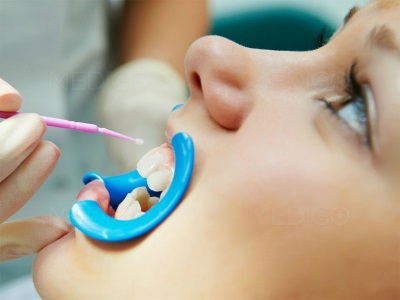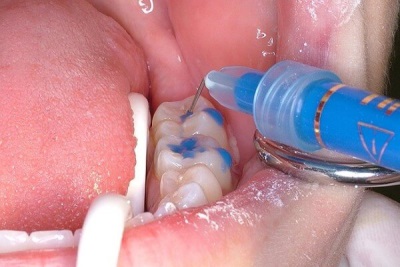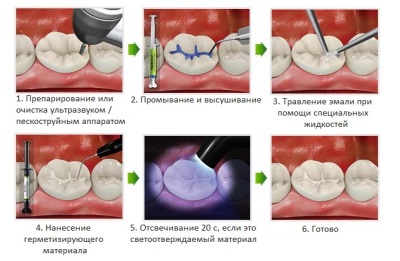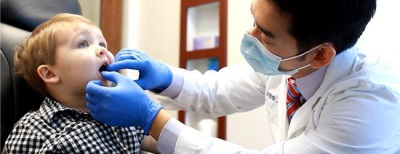Sealing fissure in children
Caries is a serious and common problem in childhood. Since baby milk teeth are less durable, and cleaning is often not performed well enough, bacteria actively develop on their surface, causing damage to the teeth. To prevent this situation, use different protective techniques. One of them is the sealing of fissures.
What is it?
So called special surface treatment of the teeth, and if more precisely, the most vulnerable to caries areas, called fissures. These areas are located in the recesses of the chewing teeth and are often poorly cleaned during normal hygienic cleaning. The essence of sealing is to fill the recesses with a durable material that eliminates the contact of the tooth with bacteria and food.
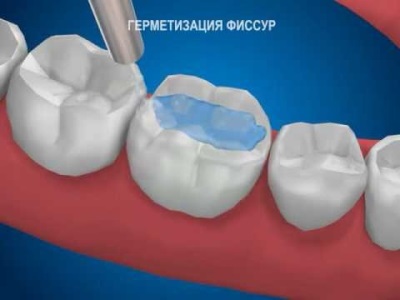
The procedure is completely painless, so children tolerate it well. Another advantage of the use of sealing in children is to strengthen the enamel. A tooth that has just broken through is not strong enough (not completely mineralized), therefore its resistance to bacteria is reduced. And since hygiene measures in children cannot be called ideal, and many babies love sweets very much, protecting their teeth with a sealant is a good solution.
Indications
Sealing prescribed after inspection by a dentist, if the child:
- Fissures in the teeth are deep and narrow.
- Fissures are pigmented, that is, they began to break down under the influence of bacteria.
- Fissures of one of the teeth are affected by caries.
- There is no tooth on the opposite side or it is affected by tooth decay.
- Oral hygiene is insufficient.
Contraindications
The procedure is not prescribed if:
- Fissures wide and open.
- The child has intolerance of the substance used in sealing.
- The tooth is affected by caries.
- The adjacent surfaces of adjacent teeth are affected by caries.
- The tooth erupted more than four years ago and is not affected by caries.
Methods and materials for the procedure
For sealing use a material called a silant. it high-strength special composite that hardens after light hits it. He noted high turnover, which allows the substance to get into the most inaccessible areas of the teeth.
In addition, the silant is moisture resistant, that is, the constant contact of saliva does not harm it. Because of these characteristics, the sealant applied to the teeth serves an average of 3-5 years, although there are cases when it remained on the teeth for more than 10 years.
The hardening of the silant can be caused in two ways:
- Exposure to light. The substance hardens after using the lamp.
- Chemical exposure. Hardening occurs as a result of a chemical reaction.
Note also that the sealant is transparent (it is applied at high risk of caries in fissures) and color (it is preferred to facilitate monitoring of the integrity of the coating). The most common drugs are Fissolight, UltraSeal XT and Fissurit.
How is the sealing procedure
Baby teeth
It is recommended to “seal” temporary teeth with sealant immediately after their eruption, when the fissures are no longer covered with soft gingival tissues. Often this occurs at the age of 2-2.5 years.If you hesitate with carrying out sealing, you may not have time to process it, since caries of chewing teeth at such an early age occurs rather quickly.
Permanent teeth
Treatment with sealant of such teeth is also recommended immediately after their eruption. Sealing is usually carried out in the first 6 months after a permanent tooth has appeared. At this time, its chewing surface is available for processing, and the enamel is not yet destroyed by the action of pathogenic bacteria.
Stages of the procedure
- The doctor performs professional cleaning in order to remove plaque from treated teeth as much as possible and to achieve a dry and smooth surface.
- Teeth are washed and dried, and then laid with cotton swabs so that they do not get saliva.
- The tooth is covered with a special glue to obtain a rough surface.
- The tooth is again washed and dried, after which a silant is applied to the fissures, distributing the substance evenly with a probe.
- Using a lamp, the doctor stimulates the hardening of the sealant and checks the occupancy of the fissures.
- With a copy paper, the dentist identifies areas of application of the excess substance, after which it removes them with a grinding nozzle.
You can clearly see this procedure in the next video.
Reviews
Most parents speak positively of sealing fissures, emphasizing that teeth treated with sealant are, in most cases, not affected by caries. They also note that manipulation does not cause any discomfort to the child, which has a positive psychotherapeutic effect - children come to the next inspection calmly. In addition, all parents emphasize that the cost of the procedure is much lower than the treatment of caries.
Negative feedback on sealing is often associated with the lack of professionalism of the dentist, because of which the sealant did not serve long or did not protect against caries, for example, if the doctor examined the fissure caries and sealed the affected tooth from above. Some doctors also respond to treatment with silant negatively. They are sure that in many cases such a procedure is not needed, but should only pay more attention to the hygiene and nutrition of the child.
To learn more about the sealing of fissures, indications for it and contraindications can be in the following video.

